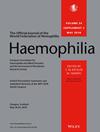Development and validation of the Child Hemophilia Treatment Experience Measure: A new observer-reported outcome measure
Abstract
Introduction
The Child Hemophilia Treatment Experience Measure (Child Hemo-TEM) was developed to capture the treatment burden experience of children with haemophilia (CwH).
Aim
Describe the development of this novel haemophilia-specific measure.
Methods
Interviews were conducted with clinical experts, CwH and CwH's caregivers. Interviews were analysed according to adapted grounded theory principles. Based on the analysis, a preliminary measure was developed and debriefed. Psychometric analyses were performed according to an a priori analysis plan using data collected in a cross-sectional web survey and a final measure was generated.
Results
Interviews with four clinical experts, 25 CwH ages 8 to <12 years, and 25 caregivers of CwH <12 years were conducted. Concepts endorsed by ≥10% of CwH and caregivers were: adherence, ease of use, emotional impacts, physical impacts, treatment concerns, and interference with daily life. Cognitive debriefing assessments were conducted to ensure participant understanding and item relevance. Caregivers found the measure to be understandable, comprehensive, and relevant. However, several issues with CwH completing the measure were identified and it was decided to only develop an observer-reported outcome version. Data for psychometric validation was collected in a web survey (N = 187). Item reduction dropped 12 items. Factor analysis generated a single, 7-item, internally consistent (α = .855) factor, which consisted of items covering all relevant a priori concepts. The majority of a priori convergent and all known groups validity hypotheses were confirmed.
Conclusions
The study findings provide evidence that the Child Hemo-TEM is a brief, well-designed, and valid and reliable measure of haemophilia treatment burden.


 求助内容:
求助内容: 应助结果提醒方式:
应助结果提醒方式:


